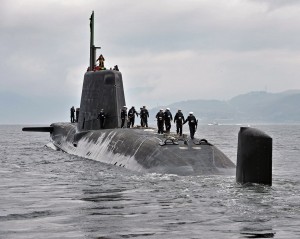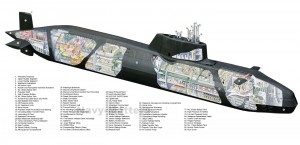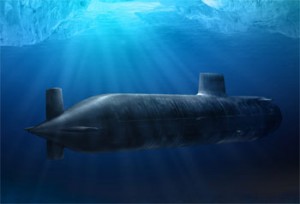Inside a Submarine
HMS Astute is the first in a program to design seven Astute-class subs to replace the Royal Navy’s aging Swiftsure and Trafalgar-class. Three similar subs (Ambush, Artful and Audacious! have already been approved to follow.
Around 6,000 people were involved in Astute’s construction at BAE’s Devonshire Dock Hall in Barrow-in-Furness, the largest shipbuilding construction complex of its kind in Europe, covering an area of 25,000 square metres. Astute’s construction required over 1 million components including 7,000 design drawings., 10,000 separate engineering requirements and 100 km of pipework.
A number of technical challenges had to be overcome during the 17-year cycle from concept design to nuclear-powered vessel. Not least of these was the fact that with space at an absolute premium, Astute’s machinery and equipment is three times more densely packed than that of a surface warship.
Astute was the first nuclear submarine to be designed entirely in a 3D Computer Aided Design environment. With very little time or budget for designing a prototype in the usual manner, this system of ‘virtual’ prototyping harnessed the power of computer test and visualization, along with continuous design and careful systems analysis. Some areas of the Astute, such as the command deck and forward engine room, were manufactured in modules, assembled in the workshop. They were then shipped to the Devonshire dock hall and carefully placed within the hull; an example of ‘plug and play’ construction that not only saved time but also minimized rework.
 The structure of the sub is made up of a pressure hull – a perfect cylinder with rounded dome ends demonstrating that circularity is one of the keys to surviving deep ocean pressures. There are six sections between the end domes each containing different packages of equipment, and the hull sections are meticulously welded together in a process involving more than two kilometres of welding, all completed without a single defect and exhaustively examined for flaws using x-ray and ultra-sonic technology.
The structure of the sub is made up of a pressure hull – a perfect cylinder with rounded dome ends demonstrating that circularity is one of the keys to surviving deep ocean pressures. There are six sections between the end domes each containing different packages of equipment, and the hull sections are meticulously welded together in a process involving more than two kilometres of welding, all completed without a single defect and exhaustively examined for flaws using x-ray and ultra-sonic technology.
How does a reactor power a submarine?
Astute’s Rolls Royce PWR2 (Pressurised Water Reactor) contains enough nuclear fuel to power the submarine for its entire 25-year service. This energy is generated by nuclear fission that takes place inside a heavy shielded reactor compartment that protects the crew and environment from radiation.
Water is pumped around a circuit where it is heated by the fission process, maintaining enough pressure to prevent the water from boiling. This heat is then used to generate steam, via steam generators, to drive the main turbine engines. A system of clutches and gearing drive a propulsor that transmits the power to propel the submarine. Steam is also used to drive the turbogenerators that supply the submarine with electricity.
Is it packing weapons?
 When it comes to offensive capability, Astute marks a significant leap over the submarine classes it replaces. With a total of 38 Spearfish torpedoes and Tomahawk missiles – more than any previous RN submarine – and six 21-inch torpedo tubes, Astute has the capability to accurately engage targets over 1,000 miles away while remaining undetected.
When it comes to offensive capability, Astute marks a significant leap over the submarine classes it replaces. With a total of 38 Spearfish torpedoes and Tomahawk missiles – more than any previous RN submarine – and six 21-inch torpedo tubes, Astute has the capability to accurately engage targets over 1,000 miles away while remaining undetected.
Powered by a high-performance thermal engine, Spearfish has an analogue homing system and communicates with the launch submarine through a wire-guidance link.
Meanwhile the Tomahawk Block IV Land Attack Missile (LAM) is the latest version of McDonnell Douglas’s medium-to-long range cruise missiles, designed to operate at low attitude and launch while the Astute is submerged. It can deliver pin-point strikes 2,000 km from the coast.
How do submarines dive?
Like ships, submarines can float because the weight of water that they displace is equal to their weight, creating a buoyant force that counteracts gravity. However, the main competency of the submarine is its ability to exist and travel while totally submerged, diving to incredible depths. So how does it vary the buoyant force acting upon it in order to do so?
 To control buoyancy, modern submarines utilize a system of ballast tanks positioned between a double hull. The ballast tanks can be filled either with pressurized air, which reduces the submarine’s overall density, or water from the ocean, which increases it. This is achieved by a series of vents and hydraulic panels that move in sync depending on the submarine’s manoeuvre. If diving, air from the ballast tanks is vented out of the vessel and replaced with water, and if ascending, vice versa. To maintain a set depth, the submarine then merely balances the load in the ballast accordingly to generate equilibrium.
To control buoyancy, modern submarines utilize a system of ballast tanks positioned between a double hull. The ballast tanks can be filled either with pressurized air, which reduces the submarine’s overall density, or water from the ocean, which increases it. This is achieved by a series of vents and hydraulic panels that move in sync depending on the submarine’s manoeuvre. If diving, air from the ballast tanks is vented out of the vessel and replaced with water, and if ascending, vice versa. To maintain a set depth, the submarine then merely balances the load in the ballast accordingly to generate equilibrium.
In addition to the ballast system, submarines are also fitted with sets of short, wing-shaped hydroplanes that can be adjusted dependent on the angle of the dive needed. These hydroplanes work by forcing passing water over the submarine’s stern, which forces it downwards.

